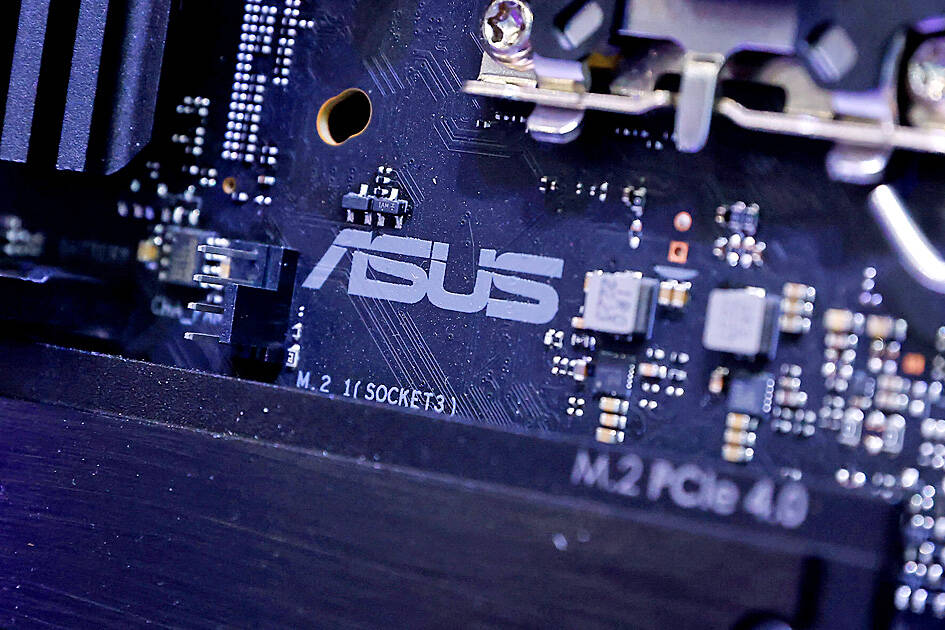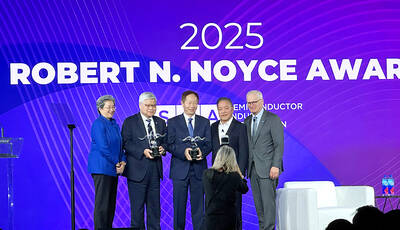PC vendor Asustek Computer Inc (華碩) is restructuring after posting its first quarterly losses in four years last quarter, it said yesterday.
The company hopes to expand its commercial PC market share to 10 percent from 5 percent, Asustek cochief executive officer Samson Hu (胡書賓) said at an online media briefing.
Commercial PC business is the second-biggest business group of the company, with a headcount of 540, Asustek said.

Photo: REUTERS
Asustek hopes to safeguard its leading position in the gaming PC market, Hu said.
The restructuring would not lead to massive layoffs, Hu said, dismissing media reports that the company was planning to cut up to 800 jobs.
Only a very small number of positions could be axed, as the company has about 600 vacancies that need to be filled, he added.
“The company’s structural adjustments do not aim to cut jobs, but to optimize the company’s operations and improve its agility, allowing the company to quickly respond to rapid market changes,” Hu said.
The global PC industry has faced challenges over the past few quarters in terms of macroeconomic conditions, supply chain issues and consumer demand, Hu said.
Asustek reported net losses of NT$3.82 billion (US$124.33 million) last quarter, which the company blamed on high channel inventories and disappointing PC sales.
Under the company’s restructuring plans, Asustek has divided its businesses into three categories: the consumer product business group, commercial product business group and mobile product business group. Gaming PCs would be included in the consumer product business group.
Asustek gaming PC business head Chang Yang-kuang. (張仰光) is to oversee the company’s consumer product business group, while Chang Kai-shun (張凱舜) would take charge of the commercial product and mobile business groups.
The adjustments are to take effect on July 1.

Shiina Ito has had fewer Chinese customers at her Tokyo jewelry shop since Beijing issued a travel warning in the wake of a diplomatic spat, but she said she was not concerned. A souring of Tokyo-Beijing relations this month, following remarks by Japanese Prime Minister Sanae Takaichi about Taiwan, has fueled concerns about the impact on the ritzy boutiques, noodle joints and hotels where holidaymakers spend their cash. However, businesses in Tokyo largely shrugged off any anxiety. “Since there are fewer Chinese customers, it’s become a bit easier for Japanese shoppers to visit, so our sales haven’t really dropped,” Ito

The number of Taiwanese working in the US rose to a record high of 137,000 last year, driven largely by Taiwan Semiconductor Manufacturing Co’s (TSMC, 台積電) rapid overseas expansion, according to government data released yesterday. A total of 666,000 Taiwanese nationals were employed abroad last year, an increase of 45,000 from 2023 and the highest level since the COVID-19 pandemic, data from the Directorate-General of Budget, Accounting and Statistics (DGBAS) showed. Overseas employment had steadily increased between 2009 and 2019, peaking at 739,000, before plunging to 319,000 in 2021 amid US-China trade tensions, global supply chain shifts, reshoring by Taiwanese companies and

Taiwan Semiconductor Manufacturing Co (TSMC, 台積電) received about NT$147 billion (US$4.71 billion) in subsidies from the US, Japanese, German and Chinese governments over the past two years for its global expansion. Financial data compiled by the world’s largest contract chipmaker showed the company secured NT$4.77 billion in subsidies from the governments in the third quarter, bringing the total for the first three quarters of the year to about NT$71.9 billion. Along with the NT$75.16 billion in financial aid TSMC received last year, the chipmaker obtained NT$147 billion in subsidies in almost two years, the data showed. The subsidies received by its subsidiaries —

Taiwan Semiconductor Manufacturing Co (TSMC) Chairman C.C. Wei (魏哲家) and the company’s former chairman, Mark Liu (劉德音), both received the Robert N. Noyce Award -- the semiconductor industry’s highest honor -- in San Jose, California, on Thursday (local time). Speaking at the award event, Liu, who retired last year, expressed gratitude to his wife, his dissertation advisor at the University of California, Berkeley, his supervisors at AT&T Bell Laboratories -- where he worked on optical fiber communication systems before joining TSMC, TSMC partners, and industry colleagues. Liu said that working alongside TSMC